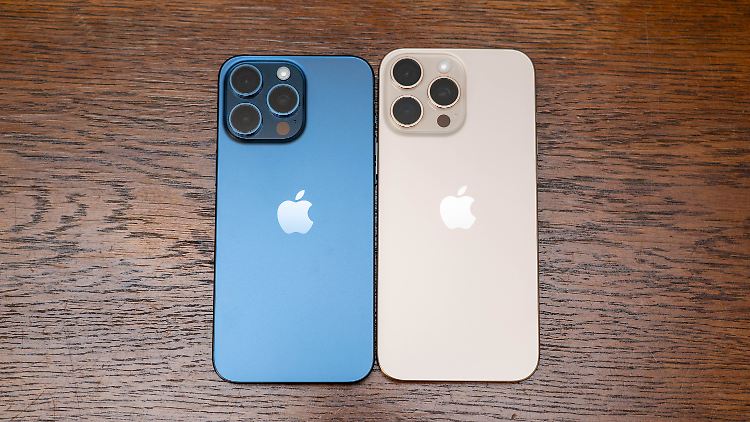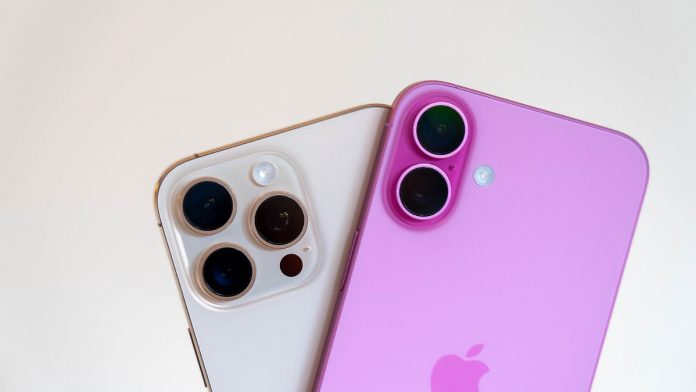The iPhone 16 and iPhone 16 Pro are excellent, extremely powerful smartphones. But because Apple is in dispute with the EU, German users can look forward to new buttons, great cameras and outstanding endurance for the time being.
It's a shame that the iPhone 16 and iPhone 16 Pro will have to make do without new AI functions in Germany for the time being because Apple does not want to accept EU rules. The company told ntv.de that it wants to make the AI functions available in German next year, but this only applies to supported countries outside the EU for the time being. The company is striving for an agreement with the EU, but Apple could not give a possible time frame.
Strong even without Apple Intelligence
But even without new AI functions, the new iPhones have a lot to offer, as the practical test by ntv.de shows. The standard models in particular have received a number of technical innovations that significantly improve their value. These include the extremely powerful A18 chip, action and new camera buttons, and a new ultra-wide-angle camera. The Pros keep the normal ones at bay with their new size, better displays, more powerful cameras, and an even more powerful chip.
After Apple recently equipped the standard devices with significantly less features than its Pro duo, the difference is hardly noticeable with the iPhone 16. In principle, you only have to do without the telephoto camera and, unfortunately, still without a 120-hertz screen. You don't notice that the A18 chip is not quite as powerful as the A18 Pro; in benchmark tests, the iPhone 16 clearly beats the iPhone 15 Pro, among others. The dual camera also leaves little to be desired.
Normal people can handle macros and audio mixing


The iPhone 16’s ultra-wide-angle camera can now also take macro photos.
(Photo: kwe)
A new pleasure for standard users is the ultra-wide-angle camera on the iPhone 16 (Plus). Although it still only offers 12 megapixels (MP), it now also enables high-quality macros with autofocus, which was a lot of fun in the practical test. In addition, the camera takes better pictures in low light with a slightly larger aperture. The 48 MP main camera has remained unchanged, but the quality of its photos and videos is a bit better than the iPhone 15 thanks to the support of the A18 chip.
The fact that the iPhone 16 (Plus) can record 3D videos for the Apple Vision Pro thanks to the vertical arrangement of the cameras will probably only be of interest to a tiny minority. However, normal people can now also do 3D audio recordings and audio mixing. This gives you a convenient way to mix voices and background noises as needed. In “In Picture” mode, for example, the voice of a person in focus is highlighted and all others are suppressed.
In practical tests, this worked with varying degrees of success depending on the situation. If there is a lot of noise in the environment and the distance to the camera is large, the effect is minimal. If the person being recorded is close and the background noise is not too loud, the audio mix works well to very well.
Talented camera control


The camera control in action.
(Photo: kwe)
The iPhone 16 (Plus) now has a brand new button called Camera Control to operate the cameras. It is located on the right side and is slightly recessed in the frame so that it cannot be activated accidentally. If you hold the device in landscape format, the button is ideally accessible with your index finger. In portrait format, this is a little more difficult. With a little practice, you can operate the button with your thumb or index finger, but without a supporting second hand, it is quite shaky.
Otherwise, you quickly get used to the camera controls. A long press opens the camera app. Another strong press takes a photo straight away; if you keep the button pressed, you record a video until you let go.


On the iPhone 16 (right), the cameras are arranged vertically.
(Photo: kwe)
In addition to quick access, you can also conveniently access other settings using the camera controls. If you press the button lightly once after starting the app, you have the option of zooming by sliding your finger over the button. The scale is then displayed in the area adjacent to the camera controls.
Sensitivity required
If you press it twice lightly, a menu opens with further settings such as aperture, exposure time or styles. You can scroll through the functions by swiping over the button; you start them with a light press. You can go back by pressing it lightly twice. An update will soon make it possible to focus with a light press and then release the shutter with a firm press. Developers can also use the button for their own apps.


The iPhone 16 Pro Max (right) in size comparison with its predecessor.
(Photo: kwe)
Since the camera controls depend on the distinction between strong and light, you can adjust this in the settings to three levels. Strangely, you won't find this under “Camera” but under “Accessibility”.
How useful the camera controls are depends on whether you use “professional settings” often. For many buyers, the button will probably only serve as a shutter release and to quickly start the camera.
Enormous endurance
The action button known from the iPhone 15 Pro (Max) is more versatile and therefore a welcome innovation for everyone on the iPhone 16 (Plus). From silent mode to shortcuts, you can use it to quickly access numerous functions.
While the A18 chip is so powerful that it doesn't reach its limits even with demanding games, it has another big advantage that is immediately noticeable. It works so efficiently that, in combination with a larger battery, the endurance of the iPhones has been significantly increased. Even with intensive use, it is almost impossible to get the batteries of the 16 series into the red zone by the time you go to bed.
Bigger and stronger pros


The Pros have a fantastic ultra-wide angle camera, …
(Photo: kwe)
The iPhone 16 Pro (Max) of course also offers all of the innovations mentioned, some of them even better, for example with more powerful microphones for audio mixing. The Pros also have larger displays with 6.3 and 6.9 inch panels. Although Apple has managed to make the edge around the screen narrower again, the devices are still a bit larger overall than their predecessors. However, the difference is still so small that you don't really feel it, you can only see it in a direct comparison.
The Pros are no longer different in terms of cameras, as the smaller model now also has a periscope telephoto lens with five times optical magnification. The main and ultra-wide-angle cameras also have improved sensors.
Even better cameras


…but they can also zoom in very close without major losses.
(Photo: kwe)
Together with the A18 Pro, which is even more powerful than the chip in the standard 16, this is mainly noticeable in the speed of the main camera, which focuses extremely quickly. The ultra-wide-angle camera now also has a 48 MP sensor, which means the images show more details. In the test, this was particularly noticeable in the macros; however, the difference to the macros on normal cameras is not huge.
The option to record videos in 4K resolution at 120 frames per second is reserved for the Pros. You can then easily select the speed you want afterwards, for example slow motion at 24 fps. This worked well in the practical test and delivered great results. Unfortunately, you cannot set different speeds for different areas of a video. 4K 120 fps videos also take up a lot of storage space. However, the iPhone 16 Pro (Max) has a USB-C port with USB 3 speed, which is why you can record the recordings directly to external media.
Conclusion
Even without Apple Intelligence, the new iPhones are a force to be reckoned with; the technology is top-notch in every respect, especially in the Pros. The standard models, however, have made the greatest progress, and are now closer to the heels of the top duo than they have been for a long time. If you need a new iPhone now, you can't go wrong with a 16-inch model.
Especially with the Pros, the improvements compared to the 15s are not so great that they make a noticeable difference in everyday life, as long as you are not completely obsessed with the new camera button. If you want to use Apple Intelligence as soon as it is available in the EU, a 15 Pro will do the job. If you don't have either, it might still be worth waiting a year. The AI functions won't come to Germany before 2025 anyway. And then you can also wait until September when the next generation comes out, which is guaranteed to be even better.


